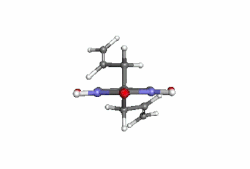 | |
 | |
| Clinical data | |
|---|---|
| Other names | 5,5-Diallylbarbituric acid, Diallylmalonylurea |
| Drug class | Barbiturate |
| ATC code | |
| Legal status | |
| Legal status |
|
| Identifiers | |
| |
| CAS Number | |
| PubChem CID | |
| ChemSpider | |
| UNII | |
| KEGG | |
| ChEMBL | |
| CompTox Dashboard (EPA) | |
| ECHA InfoCard | 100.000.129 |
| Chemical and physical data | |
| Formula | C10H12N2O3 |
| Molar mass | 208.217 g·mol−1 |
| 3D model (JSmol) | |
| |
| |
| (verify) | |
Allobarbital, also known as allobarbitone and branded as Dial, Cibalgine (in combination with aminophenazone), or Dial-Ciba (in combination with ethyl carbamate), is a barbiturate derivative invented in 1912 by Ernst Preiswerk and Ernst Grether working for CIBA. It was used primarily as an anticonvulsant [2] although it has now largely been replaced by newer drugs with improved safety profiles. Other uses for allobarbital included as an adjutant to boost the activity of analgesic drugs, and use in the treatment of insomnia and anxiety.
Allobarbital was never particularly widely used compared to better known barbiturates such as phenobarbital and secobarbital, although it saw more use in some European countries such as Bulgaria and Slovakia. [3] In Poland, it was used until the 2010's, but only as compound. [4]